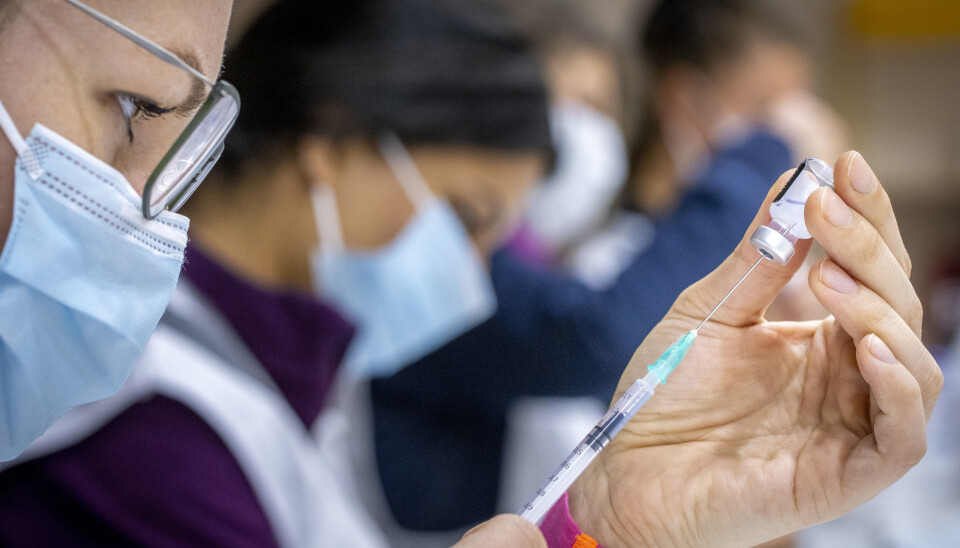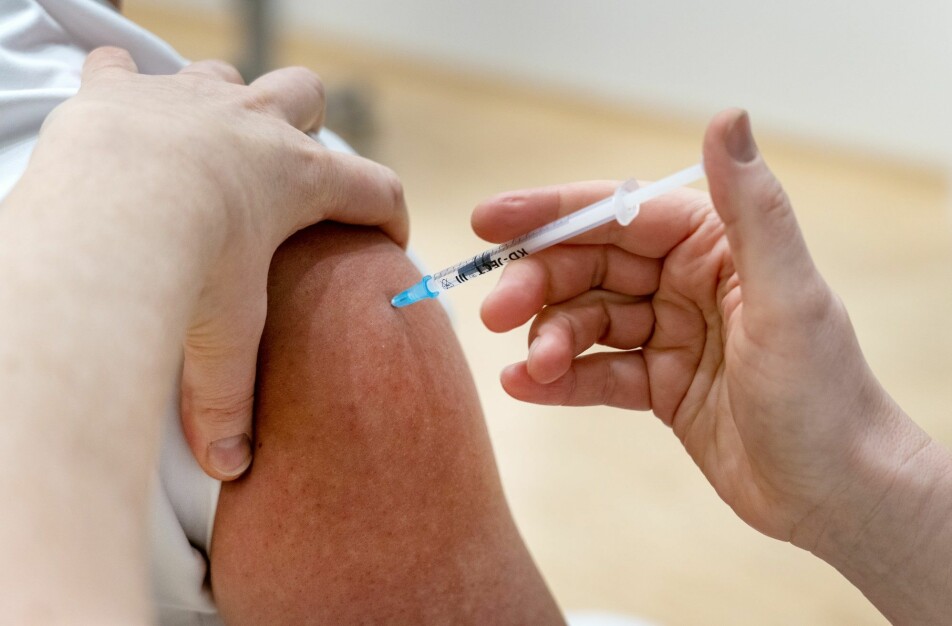
What kind of side effects do people really get from the COVID-19 vaccine? Here’s how the Norwegian Medicines Agency is answering this question
“Lots of people are being given vaccines over a very short period, so it’s important to monitor them and follow what’s happening,” says Gunnar Fløan Rimul from the Norwegian Medicines Agency.
Every day, new messages regarding possible side effects from coronavirus vaccines find their way to the Norwegian Medicines Agency.
The events they describe can range from fever — to death in the days after the shot.
As many as 13,948 messages have been received by the agency as of 27 May 2021.
But that does not mean that all these cases concern real side effects.
People get sick all the time. So when so many people are given a vaccine, some of us will — quite by chance — get sick or die in the days following the shot.
Nevertheless, there is no doubt that some people develop real side effects after the coronavirus vaccine.
So how do experts distinguish between real side effects and pure coincidence?
Own coronavirus list
The first step is to monitor all the messages that come in, says Gunnar Fløan Rimul at the Norwegian Medicines Agency.
“In order for us to be able to determine what are real side effects, we do a kind of sorting based on what we are looking for. We then have several criteria that help us look in the right place,” he says.
One of the tools they use is a special list. The list is tailored to coronavirus vaccines and is used all over the world.
The list, which goes by the name "Adverse Events of Special Interest", includes incidents such as liver damage, stroke, blood clots and allergic shock.
“These conditions have been selected based on theoretical considerations and because they are considered serious,” Rimul said.
So if someone develops any of these symptoms around the same time that they have received the coronavirus vaccine, it’s important that the Norwegian Medicines Agency respond quickly.
Well known symptoms
Because even though the conditions on the list do not necessarily have anything to do with the vaccines, there is a good reason why they ended up there.
These symptoms are well known from before.
Some are side effects from completely different vaccines. The list used in Norway and the EU includes, for example, narcolepsy, because this sleep disorder appeared as a rare side effect of the swine flu vaccine Pandemrix.
Other items on the list are severe symptoms from COVID-19, meaning complications from the disease itself.
Because the vaccine imitates the disease, there may be reason to suspect that some of the side effects may look like a coronavirus infection.

Specific codes
All messages about conditions on the list are given priority, Rimul says. This happens automatically thanks to the Side Effects Register.
Each condition is assigned a specific code. For example, fever has one code while blood clots have another.
“This makes it easy to search the databases,” says Rimul.
In other words, he and his colleagues can quickly fish out all messages that contain specific conditions.
Looking for patterns
But what about other side effects that aren’t on any list?
New, unexpected side effects may appear. Also less serious things, which should still be paid attention to.
The professionals at the Norwegian Medicines Agency have other methods for dealing with this eventuality, Rimul says.
These methods are all about finding patterns.
One compares coronavirus vaccines with other drugs.
Stands out from other drugs
Norwegian health authorities have an overview of side effect reports for all medicines.
This applies to everything from painkillers and allergy medicines to chemotherapy and the HPV vaccine.
That allows Rimul and his colleagues to check several things.
Among other things, they can find out if certain suspected side effects stand out.
If some conditions appear more often in connection to a coronavirus vaccine than for any other drug, then it’s worth the time to take a closer look at them.
Similarities strengthen suspicions
But this is just the beginning of what the professionals do.
“We still have not assessed whether there is any causal connection. But we have identified some messages that are important to look at,” Rimul says.
So the next step is the biggest job: Determining what are coincidences and what are real side effects.
Several things can strengthen the suspicion that the vaccine is the culprit, Rimul says.
For example:
If there are many messages about the same condition.
If people who have experienced the condition share similarities, such as gender, age or underlying conditions.
If roughly the same time has passed since the vaccine was given until the condition occurs.
Involves experts
If experts begin to become more suspicious that the side effect they’re hearing about is real, the professionals at the Norwegian Medicines Agency obtain more information.
They may request additional blood tests or information. They also look for possible explanations in the literature and previous research.
Sometimes they also get help from doctors and other medical groups.
For example, they ordered an independent review of the deaths at Norwegian nursing homes in the wake of the vaccine.
European cooperation
However, some side effects are more difficult to detect.
These are generally side effects that rarely occur due to the vaccine, and which are at the same time quite common in the general population.
In order to keep these kinds of potential side effects from disappearing under the radar, the Norwegian Medicines Agency compares its data with other health authorities.
It’s easier to come to a conclusion if there are a number of reports.
Among other things, they work closely with the European Medicines Agency (EMA).
AstraZeneca stood out
The severe cases of blood clots, bleeding and low platelets, which led to several deaths in Norway after the AstraZeneca vaccine, however, stood out.
“In that case, it was such a special condition and there were a number of reports at the same time. That helped us to assess it,” says Rimul.
But the hunt for AstraZeneca side effects did not end with these particular cases.
The Norwegian Medicines Agency has also collaborated closely with researchers at the Norwegian Institute of Public Health (NIPH), including Jacob Dag Berild.
“The Norwegian Medicines Agency asks if we can take a closer look at conditions that have been reported to them,” he says.
NIPH researchers have access to something that health authorities and researchers in most other countries lack:
Health information about the rest of the population.

Especially for the Nordic countries
It’s difficult to determine if rare cases are actually due to a coronavirus vaccine if you do not know how common they are otherwise.
An editor at Nature magazine described this dilemma in an editorial in that scientific journal.
But health authorities in the Nordic countries keep track of the population in large databases.
“All Nordic countries have social security numbers and large national registers, which means that we are in a relatively unique situation,” says Berild.
In addition, the Nordic countries, with universal health care, have a public health service that allows everyone who becomes ill to go to the hospital.
That’s in contrast to countries like the USA, where people who cannot afford to go to the hospital fall through the cracks.
Examined 300,000 Norwegians and Danes
The Nordic health registries have made it possible for NIPH researchers to investigate the side effects of the AstraZeneca vaccine in more detail.
Along with their Danish colleagues, they have investigated whether 300,000 AstraZeneca-vaccinated Norwegians and Danes had blood clots more often than usual.
The conclusion was that blood clots after the AstraZeneca vaccine are rare, but that it appears to be a real side effect.
Studied narcolepsy
Berild has not participated in the new study, but is working on similar projects at the Norwegian Institute of Public Health.
He says that he and his colleagues were already studying infectious diseases and side effects of vaccines before the pandemic, such as the link between the swine flu vaccine and narcolepsy.
“Normally we might go in and look at things that have happened 2-3 years ago,” says Berild.
But during the pandemic, they have jumped into the research so they can come up with answers much faster than usual.
Building trust
The monitoring of coronavirus vaccines is also a high priority area at the Norwegian Medicines Agency, Rimul said.
“Many Norwegians will be vaccinated over a very short period, so it is important to monitor and follow what’s happening. It is also important for confidence in the vaccination that it is closely followed up,” he emphasizes.
Ultimately, there is always an assessment of whether the benefit outweighs the risk.
“It’s a continuous process for all medicines,” Rimul said.
Translated by Nancy Bazilchuk.
Read the Norwegian version of this article on forskning.no.
































